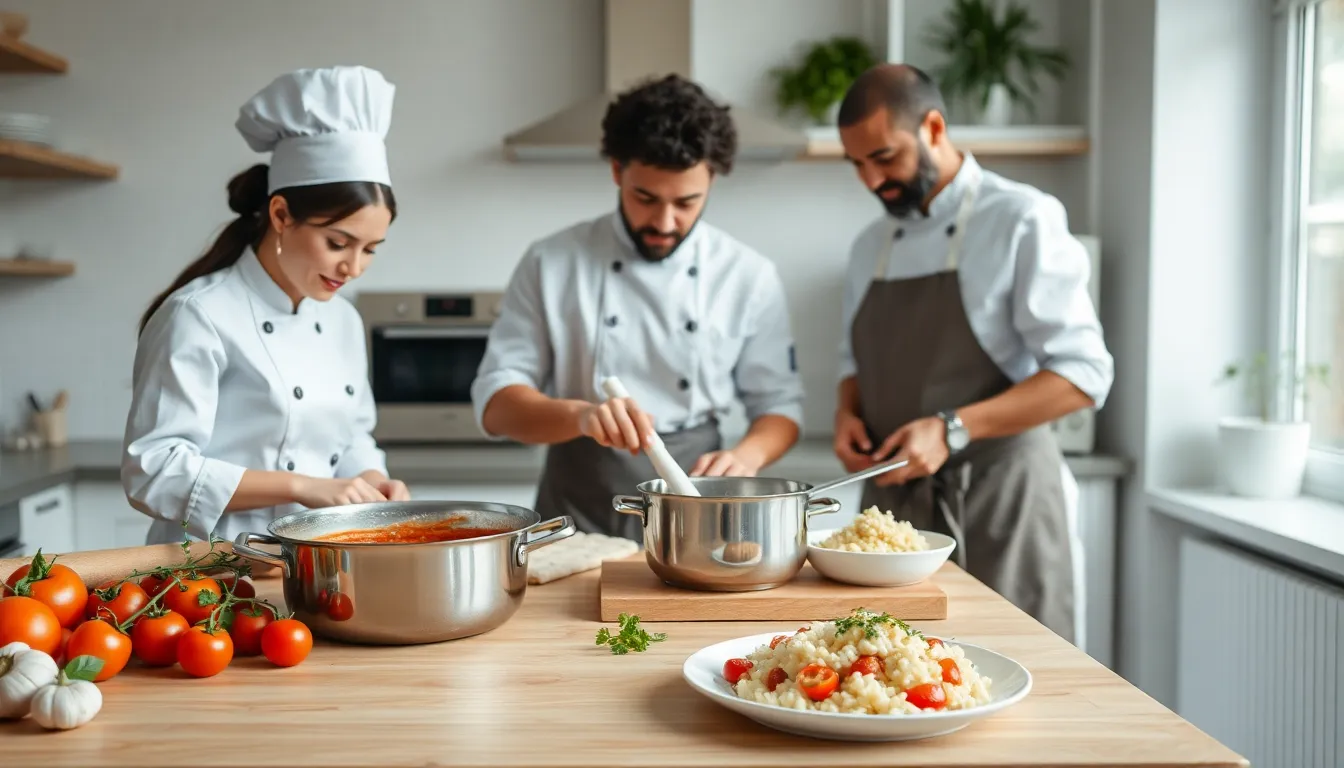Table of Contents
ToggleItalian cooking techniques are like secrets passed down through generations, whispers of culinary wisdom that can turn a humble meal into a life-changing experience. Is it the combination of fresh ingredients, the slow simmering of sauces, or perhaps the melodious symphony of herbs that captures the soul of Italy? Whatever it is, there’s something magical about Italian cuisine that has captivated taste buds around the globe. Whether you’re an aspiring chef or a curious home cook, understanding these techniques will make you feel like a maestro in your kitchen. So, let’s jump into the art of Italian cooking and learn how to whip up dishes that would make even Nonna proud.
An Overview of Traditional Italian Cooking

Traditional Italian cooking is all about simplicity and quality. At its core, this culinary style celebrates fresh, local ingredients, with each region boasting unique flavors and traditions. Think of it as a love letter to the land and the sea, where every dish tells a story. From the sun-kissed tomatoes of the south to the rich risottos of the north, Italy’s diverse landscapes influence its many flavors.
But, what truly distinguishes Italian cooking is its emphasis on technique. Whether it’s a slow-cooked sauce with layers of flavor or a perfectly baked pizza with a chewy crust, mastering the foundational techniques is essential for any cook eager to showcase Italian dishes. Get ready to roll up your sleeves and embark on a culinary adventure.
The Importance of Ingredients in Italian Cuisine
In Italian cuisine, ingredients are the stars of the show. They are the foundation upon which all great meals are built. Freshness is key: whether it’s aromatic basil from a local market or olive oil pressed just days before, quality ingredients make a world of difference.
Why is this the case? Because when ingredients are treated with care and respect, their natural flavors shine through. Think of an heirloom tomato: vibrant and bursting with flavor, it requires minimal embellishment, maybe just a sprinkle of sea salt and a drizzle of olive oil.
Emphasizing local and seasonal produce, Italian cooking encourages cooks to embrace what’s available around them. That’s how dishes are created with bold flavors while remaining rooted in tradition. It’s no wonder Italian cuisine is beloved worldwide: it invites you to connect with your surroundings and create something delicious.
Essential Cooking Techniques
Now that the spotlight is on ingredients, let’s explore some essential cooking techniques that make Italian cuisine so special.
Sautéing
Sautéing is a cornerstone of Italian cooking. Quick, high-heat cooking helps vegetables retain their bright colors and textures while enhancing flavors. Just a splash of olive oil, a pinch of salt, and you’re on your way to creating a delicious base for soups, sauces, or pasta dishes.
Braising
For those cozy days when slow is the name of the game, braising works wonders. It combines both dry and moist heat, cooking tougher cuts of meat to perfection. Picture a richly flavored osso buco, melting in your mouth after hours of slow cooking.
Roasting
Roasting is another beloved technique. Think of the charred edges of vegetables or meats, caramelized to perfection. This method elevates the natural sweetness of ingredients, creating a delightful contrast with savory elements.
Pasta Making
Of course, one cannot overlook the art of pasta making. Whether rolling sheets for lasagna or shaping gnocchi, handmade pasta calls for precision and care, delivering textures that dried pasta simply cannot replicate.
By mastering these techniques, any eager cook can create authentic Italian meals that are full of flavor and tradition.
Regional Variations in Italian Cooking
One of the most fascinating aspects of Italian cuisine is its regional diversity. Italy is comprised of many regions, each with its own distinct culinary traditions.
Take Emilia-Romagna, renowned for its rich pasta dishes, especially tagliatelle al ragù. On the other hand, Campania is famous for pizzas that boast a thin, crispy crust and quality toppings. Understanding these regional variations helps enrich any kitchen: it cultivates an appreciation for Italy’s culinary tapestry.
In the cold northern regions, such as Lombardy, creamy risottos are a staple, while Sicily offers a vibrant mix of flavors influenced by cultures from North Africa and beyond. This variety means there’s always a new dish to discover and master.
Modern Adaptations of Italian Cooking Techniques
Although rooted in tradition, Italian cooking continuously evolves. Modern chefs often reinterpret classic dishes, incorporating international ingredients or contemporary techniques. This adaptability keeps the cuisine fresh and exciting.
Many chefs now focus on health-conscious adaptations. They might use whole grains or explore plant-based options, all while retaining authentic Italian flavors. For example, gluten-free pasta is increasingly popular, allowing a wider audience to enjoy traditional meals.
Through these innovations, Italian cooking remains relevant, embracing new trends while honoring its historical roots.
Tips for Mastering Italian Cooking at Home
Ready to try your hand at Italian cooking? Here are some invaluable tips for home chefs looking to elevate their game:
- Invest in Quality Ingredients: Fresh, local produce is key. Make trips to farmers’ markets and seek high-quality olive oil.
- Don’t Rush: Good things take time. Allow flavors to meld by letting sauces simmer longer and meats braise gently.
- Practice Makes Perfect: Pasta making, kneading dough, and balancing flavors take practice. Don’t hesitate to experiment and learn from mistakes.
- Taste As You Go: Keep tasting. This fundamental practice will guide your flavor combinations and ensure balanced dishes.
- Study Authentic Recipes: Use trusted recipes from renowned chefs or regional cookbooks dedicated to the Italian culinary tradition.
By practicing these tips, anyone can create authentic and delicious Italian meals at home.



